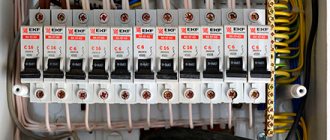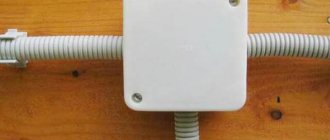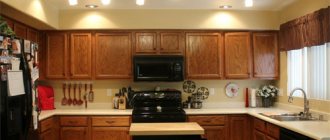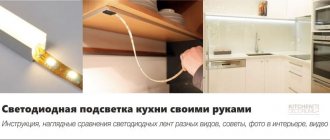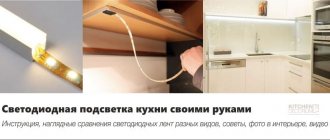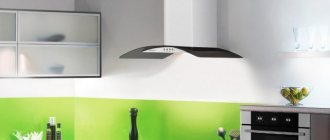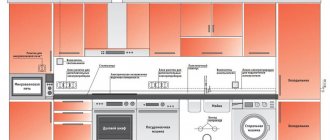When choosing kitchen appliances, including microwave ovens, consumers increasingly prefer more compact, easy-to-use models. Microwave ovens can be either free-standing or built-in – it’s up to you to decide which one to choose. But it’s better to choose a place for the equipment in advance. And based on this, you should select a model. We will tell you how to install a microwave oven and where it is best to place it. It is also important to know how to properly connect an electrical appliance so that it can be used conveniently and as safely as possible.
What types of microwave ovens are there?
Before moving directly to the installation stage, let's look at what microwave ovens exist. So:
- the simplest microwave ovens with a minimum set of functions (heating and defrosting);
- Microwave ovens with grilling function;
- models with a convection system that can easily replace your built-in oven.
What metal can be used in a microwave?
The main thing is not to use metal utensils. This is the main “contraindication” for use in a microwave oven. That is why you should also not reheat or defrost food in aluminum containers, as well as semi-finished products in foil packaging.
Interesting materials:
Damn how to take it? Accounting what is it? What are household services included? Calc clean philips how to use iron? How is partial early repayment of the loan more profitable? What are tomatoes afraid of? What should not be in baby laundry detergent? What should not be in baby laundry detergent? What is plastic made of? Whose plane is the Boeing 737?
Choosing a location and method of embedding
The installation method for microwave ovens depends on their type and location. Today there are several options for installing a built-in microwave oven. After familiarizing yourself with them, you can determine the location for the electrical appliance.
The traditional and, perhaps, the most aesthetic installation method is to integrate the microwave oven directly into the kitchen unit.
You can order a cabinet for a microwave oven along with kitchen furniture. Or find a suitable size cabinet in an existing set.
In this way, you can place the stove, for example, under the countertop, above the stove, in the upper cabinet or any other place. The built-in model can also be placed in a plasterboard niche. This type of installation is more labor-intensive; preparation for it should begin during the renovation.
The most modern, compact type of installation is placement in a drawer. The body of the electrical appliance is built directly into the drawer of the kitchen furniture. To use the microwave, you just need to pull it out of the front. This placement saves kitchen space as much as possible, and also ideally disguises the appliance itself.
As for freestanding microwave ovens, there are more options for their installation. The easiest way is to place them on a countertop or other flat surface.
But such placement often takes up a lot of space, which is sometimes not enough in the kitchen. How to install a microwave, where to put it to save work space? And most importantly, can a regular microwave be built into kitchen furniture? We'll talk about this below.
In principle, installing a conventional microwave oven is possible, but important points should be taken into account.
The main thing is to ensure proper air circulation so that the microwave does not overheat during operation.
If the niche is too narrow, it will simply be impossible to ensure the flow of cold air and the removal of warm air. For the built-in model, this process is carried out through the front panel. Therefore, it does not require any gaps in the cabinet. For free-standing electrical appliances, this is the main condition for proper operation of the device.
In the case of a conventional microwave oven, the size of the niche directly depends on its dimensions.
For models with convection, the height and width of the niche should be 20 cm greater than the height and width of the oven, the depth - 10 cm. For conventional models, 10 cm on all sides will be enough. Select the installation location taking into account the location of the free outlet.
It is not advisable to use an extension cord to connect equipment to the network.
It is not recommended to place the device close to the hob, sink, or refrigerator. This may cause it to break. The distance between household devices must be at least 45 cm.
How to choose a built-in microwave oven?
When purchasing kitchen equipment, it is advisable to take into account all the main nuances. Let's consider the most important criteria for choosing the right integrated oven for the kitchen:
- Convection appliances have the most powerful functionality. There is a grill, a fan, and this oven allows you to cook dishes in all basic ways.
- The color of the front panel is selected in accordance with the design of the facade. If a white built-in microwave oven is suitable in most cases, then a bright rich color will not always look appropriate in a simple setting.
- Chamber volume – 12 liters is enough for one user; for 3 people it is better to purchase a device from 25 liters.
- The coating is the most durable of stainless steel. Bioceramics are easy to care for, but expensive. Budget enamel lasts at least 5-7 years.
- The dimensions of the device must correspond to the dimensions of the niche.
- The power of the device affects the cooking speed.
- A quartz lamp takes up relatively less space, but a high-quality heating element grill provides more uniform heating.
Built-in microwave oven dimensions
With a huge number of home appliance manufacturers, strict sizing standards are no longer met. It is advisable to carefully study the passport data if you are purchasing an oven online. The dimensions of the built-in microwave oven depend on the volume of the chamber and are within the following limits:
- Height – 30-60 cm.
- The average depth is 30-45 cm.
- Narrow built-in microwave ovens have a width of 45-50 cm.
- Standard width is about 50-60 cm.
The process of installing a microwave oven
If the location for the device is chosen taking into account the above recommendations, you can safely proceed to the installation process itself.
Let's look at the most common installation instructions. It involves performing the following steps:
- Carefully inspect the equipment for damage and various defects.
- In the operating instructions, find the installation section and read it.
- If a mount is included, install it.
- Make a hole in the cabinet wall to provide easy access to the electrical outlet when using the device.
- Place the device in the cabinet, remove the cord, and insert the power plug into the outlet.
- Install the frame if it is included with the built-in oven. How to secure it can be found in the instruction manual. In the case of a regular microwave, there are no decorative frames. Remember its need for proper heat dissipation.
As you can see, if you look at all the points, installing the equipment yourself is quite simple. But if you doubt your abilities, consult a specialist.
However, installation of a microwave oven should be carried out taking into account all recommendations and rules. Then the electrical appliance will work correctly and will serve you for many years.
How to place a microwave in the kitchen on brackets?
For this arrangement we will need special devices, similar to corners, and a place where we want to install the microwave. Usually such a place is the apron set.
Of course, the disadvantages of this arrangement are obvious:
- the design of the headset is deteriorating
- part of the free space is taken away
- darkening of part of the work area on the tabletop, although this can be compensated for by backlighting
With this arrangement, the main thing is not to forget to make a small indentation from the upper cabinets to the microwave for ventilation.
What requirements must a cabinet for a microwave oven meet?
The microwave cabinet must have a durable structure that can support the weight of the household appliance. The cabinet under the microwave oven must provide ventilation to remove hot air. In the designs of kitchen modules for built-in appliances, the air duct can be represented by a grille or technical openings. In some models, the issue of free air circulation is resolved due to the complete absence of the rear wall.
Basic rules for placement
Since you have to use a microwave oven often, you need to pay due attention to where it is placed.
General requirements for placement:
- optimal height from the floor – 60-150 cm;
- should not be placed near a stove, oven, radiator or other heating appliances;
- position it so that you can easily reach it with your hand;
- do not place the microwave oven next to the sink;
- make sure that nothing prevents the door from opening and closing;
- ventilation openings must not be blocked. They are usually located on the top panel. If particles of food or water get there, the device may burn;
- Do not store interior items or kitchen utensils on the appliance.
Ignoring advice on ergonomic and safe placement is not recommended. Due to improper use, the microwave oven will quickly break down, and if it is inconveniently positioned, you risk spilling hot food on yourself and getting burned.
Additional options
The comfort of using technology depends not only on the main functions, but also on the little things. Everything from the door opening to the interior materials matters.
The maximum timer time is important if you plan to use the microwave for cooking. Varies mainly from 30 minutes to several hours. If you like recipes with long simmering times, choose 90 minutes or more so that you don’t have to manually start the process again.
Delayed start is not present in all models, but it can be useful if you clearly plan your time and do not like to be distracted by household chores. You can, for example, marinate meat in the morning by programming the microwave to turn on for the evening - a delicious, hot dinner is ready for your arrival.
Mute the sound. All microwave ovens indicate the end of the cooking cycle with a sound signal. But this can become a hindrance if there is a small child with a light sleep in the house or you do not live alone in a studio apartment. Although this is not the most important option, it is sometimes very pleasant.
Design
Built-in microwaves have an attractive facade and a “rough” body that is completely hidden in the furniture. The front part of the device can be made in a variety of styles - from strict steel high-tech to vanilla Provence with bronze handles. Selecting a model to match the overall style of the kitchen and other appliances will not be difficult.
If we talk about design features, it is worth mentioning that not all modern microwave ovens have a traditional door opening. Nowadays there are many models with a door that hinges from top to bottom in the style of an oven. The choice depends solely on your convenience. However, it is worth considering the height of the microwave - if it is installed too high, the hinged door can create significant inconvenience.
The diameter of the tray will dictate how you can use a particular dish. Usually it is from 24 to 32, less often 36 cm in a microwave oven. There are trays that are larger, but this is already rare. Pay attention to this detail if you not only plan to cook with it, but also in large quantities. Due to the fact that the tray rotates during operation of the microwave, it is strictly not recommended to use dishes that are significantly larger than the tray.
By the way, modern microwave ovens are often equipped not only with a rotating tray, but also with baking trays at different levels.
The inside of microwave ovens is usually lined with either stainless steel or enamel .
Enamel is more affordable, easy to clean, and looks nice (if it’s important for you to admire the inside of the device). It cannot be cleaned with powders or hard brushes. Over time, it can gradually chip and provoke rust in the cracks.
Stainless steel is much more practical. It is much easier to wash away greasy deposits or soup that accidentally spills from a plate. Over the years, nothing happens to her. If you clean too hard with abrasives, it may get slightly scratched, but this will not affect performance in any way. It is worth noting that most models of built-in microwave ovens are made of stainless steel.
Child lock needs no introduction. Of course, microwaves automatically turn off when the door is opened. But in order to avoid unwanted children's experiments and other unforeseen circumstances, the blocking function is still a necessary and useful thing.
Source: club.dns-shop.ru
Rating of built-in microwave ovens
- Built-in microwave oven Bosch BFL 634GS1
– stainless steel coating, 7 programs, 900 W, volume 21 l, grill, dimensions 59.4x38.2x31.8 cm. - Built-in microwave oven Electrolux EMS 26004 OK
- budget device 25 l, 900 W, auto-defrost, childproof, push-button control. Dimensions – 59.4 x 45.9 x 41.7 cm. Cons – lack of convection and grill. - Whirlpool AMW 730/WH
– chamber 31 l, 1000 W, electronic panel, display. Dimensions – 59.5x38.5x46.8 cm. - Indesit MWI 222.2
– grill and convection, 900 W, 25 l, push-button and rotary switches, display. Dimensions – 59.5x38.8x45 cm. - Kaiser EH 6319
– grill, convection, steamer, 19 cooking modes, 38 l, display. Dimensions – 59.5x52x45.5 cm.
Location
The microwave oven must not be installed:
- Under the sink or boiler. A leak at any water supply or sewer connection (in the case of a boiler, the safety valve drain outlet) can lead to a short circuit and fire;
- Above the oven or stove. The rising flow of hot air will heat the stove to high temperatures that threaten to damage the insulation.
The microwave compartment is located away from the stove
In addition: when the microwave oven is located in the lower cabinet, next to the oven, its compartment must be additionally insulated with a heat-resistant material with low thermal conductivity (for example, multi-layer lavsan).

